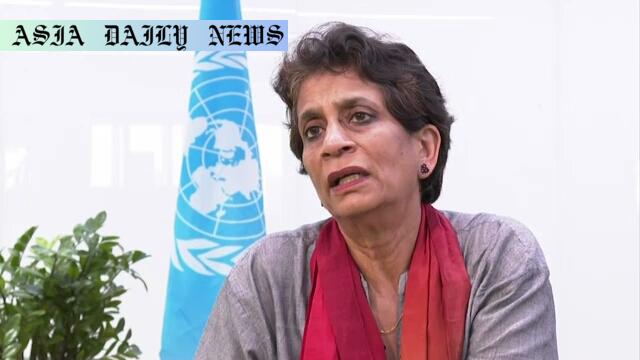Myanmar Earthquake Relief: UN ramps up support for women and children amid a devastating quake in central Myanmar, rebuilding efforts are underway.
- UN aims to aid women and children in Myanmar post-earthquake.
- Over 3,700 lives have been lost, and reconstruction is ongoing.
- Temporary shelters lack safety measures, causing vulnerability.
- Call for a permanent ceasefire to ensure smoother relief efforts.

Introduction: Addressing a Tragedy
One month has passed since a catastrophic earthquake struck the central region of Myanmar, leaving significant devastation in its wake. Official records from the ruling junta indicate over 3,700 lives lost, with thousands more displaced in its aftermath. While the tragic event has shaken the nation, relief efforts have provided a glimmer of hope, particularly for the most affected demographic: women and children. The United Nations has stepped up efforts to rebuild and secure a safer environment for the survivors, with a key focus on access to medical care and shelter security. As the reconstruing process accelerates, international attention remains directed towards Myanmar’s recovery journey and its lingering socio-political instability.
The Scope of the Disaster
The earthquake’s epicenter was located in northwest Sagaing, a region that bore the brunt of the disaster. Alongside significant loss of life, critical infrastructure, including hospitals, clinics, and educational institutions, has been damaged or destroyed. Consequently, the local population faces an uphill battle in gaining access to vital healthcare services. Women and children, in particular, have been disproportionately affected, as they lack both medical treatment and basic privacy in temporary shelters. According to Kanni Wignaraja, Regional Director for Asia and the Pacific at the United Nations Development Programme (UNDP), immediate measures must address these vulnerabilities while taking into account the necessity of long-term development.
Temporary Shelters and the Challenge of Safety
One of the most pressing issues highlighted by the UNDP is the safety and well-being of women and children living in temporary evacuation shelters. Without adequate security protocols and infrastructure, these individuals face heightened risks of violence and abuse. “In these disasters, with temporary shelters, you have to make sure that there is safety for women and children,” Wignaraja emphasized during an NHK interview. This underlines the broader need for organized interventions and partnerships among international organizations to establish secure and dignified living conditions for vulnerable populations.
Calls for a Permanent Ceasefire
Amid the struggle for recovery, Myanmar’s political tensions have slightly eased, with both the junta and pro-democracy forces agreeing to a temporary ceasefire in affected areas. While this truce aims to facilitate relief and reconstruction efforts, sporadic fighting continues in select regions. Wignaraja has called for international commitment to foster a lasting peace agreement. A permanent ceasefire would allow uninterrupted support and expedite the road to recovery, potentially transforming the nation’s post-disaster trajectory.
The UN’s Vision for Reconstruction
The United Nations, alongside other humanitarian initiatives, has provided both immediate and calculated support to Myanmar’s earthquake victims. Priorities include restoring healthcare facilities, reinforcing shelter safety, and ensuring psychological support services for traumatized victims. While there is a significant focus on women and children, the larger goal remains inclusive reconstruction that provides foundational stability for every community affected. The UN has clearly indicated its commitment to long-term backing, supported by collaborations with local stakeholders and governments willing to mediate peace and reconstruction efficiently.
Conclusion: A Work in Progress
Myanmar’s road to recovery is undeniably a challenging one. Yet, the proactive efforts of the United Nations and other global entities spark hope that even amid devastation, there lies potential for resilience and renewal. The current strategy insists on balancing immediate relief with strategic reconstruction, all while promoting safety, dignity, and peace. Considering the fragile socio-political climate, Myanmar’s recovery will require immense patience and global cooperation, emphasizing the need for continued vigilance, financial aid, and diplomatic engagement.



Commentary
The Necessity of Focused Humanitarian Aid
The tragedy that has unfolded in Myanmar following the recent earthquake serves as a crucial reminder of the pressing need for inclusive humanitarian interventions. When disasters strike, they disproportionately affect the most vulnerable populations – women and children. Temporary shelters become more than just a physical space to convene; they become microcosms of vulnerability. Addressing challenges like insecurity, lack of privacy, and insufficient medical facilities should be the global community’s immediate priority to ensure effective relief work.
Reconstruction Beyond Buildings
While rebuilding hospitals, schools, and other essential infrastructure takes time, relief efforts must look beyond tangible reconstruction. Social restoration – particularly safeguarding the physical, medical, and emotional well-being of displaced individuals – remains equally crucial during and after recovery. For Myanmar, whose political struggles have compounded its humanitarian crisis, the incorporation of these broader needs in aid programs might very well decide the country’s recovery trajectory.
A Call to Prioritize Peace
A critical element that cannot be overlooked is Myanmar’s unique political landscape. The temporary ceasefire agreed upon by conflicting factions is undoubtedly a positive development, but it is fragile at best. Relief organizations and stakeholders must advocate for sustained dialogue and peaceful resolution of conflicts. Without long-term peace, reconstruction efforts will remain stifled, and lives will continue to hang in the balance.
The Role of the Global Community
Myanmar’s tale resonates as a rallying call for stronger international collaboration in disaster response strategies. Governments, NGOs, and private entities must mobilize both funding and human resources to not only meet immediate needs but also empower local populations to rebuild sustainably. It’s essential to recognize that every action – or inaction – in the international sphere contributes directly to healing or hindering the lives of people most affected by such crises.